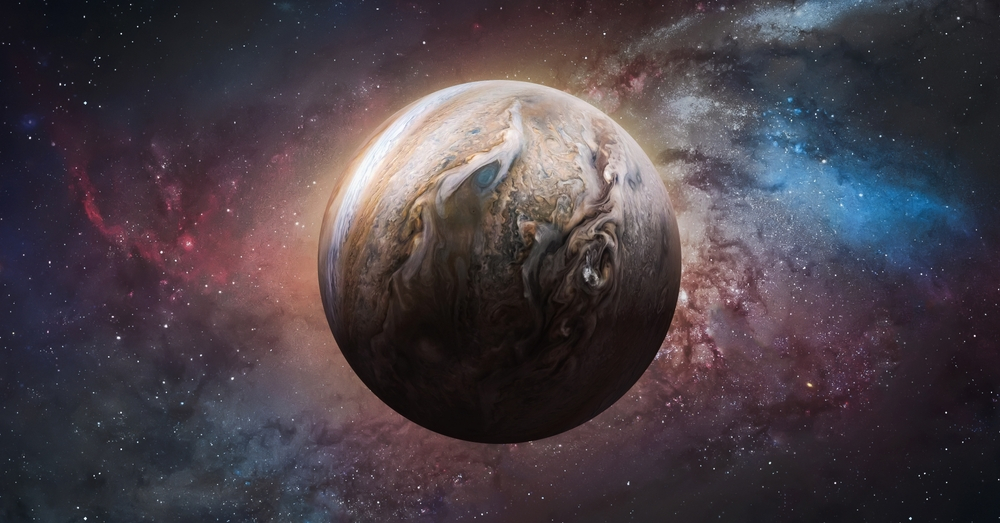Three Captivating Facts About Jupiter’s Mysteries

Jupiter, the fifth planet from the sun, stands as a colossal presence in our solar system. This gas giant, known for its swirling cloud formations and vivid bands, is more than just a spectacle to behold; it plays an immense role in the dynamics of our cosmic neighborhood. As the largest planet, Jupiter’s mass is over twice that of all other planets combined, earning it the title of the solar system’s mighty monarch.
The enchanting allure of Jupiter goes beyond its size and aesthetic appeal. Scientists and astronomers have long been captivated by its numerous moons, intense magnetic field, and turbulent atmosphere. These aspects not only fuel our curiosity but also hold keys to understanding the broader mechanisms at play within our solar system.
Jupiter’s mysteries, such as its iconic Great Red Spot, powerful magnetic field, and potential water clouds, continue to intrigue researchers, prompting ongoing explorations and studies. In this blog, we will delve into three particularly fascinating facets of this giant planet, each contributing to our growing fascination and knowledge of Jupiter’s enigmatic nature.
Fact 1: The Great Red Spot
One of Jupiter’s most iconic features is the Great Red Spot, a colossal storm that has been raging for at least 400 years. This vast anticyclonic storm, large enough to engulf Earth two to three times over, is an oval-shaped vortex boasting a striking reddish hue. Historical observations date back to the 17th century when astronomers like Giovanni Cassini and Robert Hooke first documented this massive tempest.
Despite its long-standing presence, the exact reason for its persistent longevity remains a subject of scientific investigation. Some theories suggest that Jupiter’s lack of a solid surface allows storms like the Great Red Spot to endure for centuries, while others point to the planet’s internal heat and the energy it injects into the atmosphere as contributing factors.
The mystery of the Great Red Spot continues to fascinate scientists, serving as a dynamic laboratory for studying atmospheric dynamics and longevity of planetary storms.
Fact 2: Jupiter’s Magnetic Field
Jupiter’s magnetic field is one of the most powerful and extensive structures in the solar system, stretching millions of miles beyond the planet itself. Unlike Earth’s relatively small magnetic field, Jupiter’s is a colossal magnetosphere, roughly 20,000 times stronger. This intensity is a byproduct of the planet’s rapid rotation and its metallic hydrogen core, which generates a robust magnetic dynamo effect.
The impact of this formidable magnetic field extends well beyond Jupiter, influencing its atmosphere and its moons. For instance, charged particles trapped within Jupiter’s magnetosphere create intense radiation belts, which can affect the surface conditions of moons like Europa and Io.
These interactions not only shield Jupiter from solar winds but also play a crucial role in shaping the space environment around the gas giant, making Jupiter’s magnetic field a key factor in the planetary system’s dynamics.
Fact 3: The Possibility of Water Clouds
The possibility of water clouds in Jupiter’s atmosphere has generated considerable excitement in the scientific community. Recent evidence from space missions and telescopic observations has detected water vapor in the upper atmosphere of the gas giant, suggesting the presence of water clouds beneath its thick cloud cover.
This discovery carries significant implications, both for the composition of Jupiter’s atmosphere and our understanding of its complex climate and weather patterns. The existence of water clouds could mean that Jupiter experiences weather systems similar to those on Earth, albeit on a much larger and more intense scale.
Understanding the formation and behavior of these potential water clouds could provide deeper insights into the atmospheric dynamics of Jupiter, aiding scientists in drawing parallels to other planetary atmospheres, including our own. This emerging evidence continues to fuel interest and further investigation into the enigmatic meteorology of our solar system’s largest planet.
Conclusion
In summary, our exploration of Jupiter has brought to light three of its most captivating mysteries: the enduring Great Red Spot, the immense magnetic field, and the potential existence of water clouds. Each of these features not only adds to the grandeur of Jupiter but also deepens our understanding of this gas giant and its role within the solar system.
The Great Red Spot, an anticyclonic storm persisting for centuries, provides crucial insights into atmospheric dynamics and longevity. Jupiter’s powerful magnetic field, a colossal force generated by its rapid rotation and metallic hydrogen core, significantly influences the planet’s atmosphere and its diverse moons. Lastly, the potential presence of water clouds hints at complex weather patterns, akin to those on Earth, driving further scientific inquiry.
Jupiter’s mysteries continue to captivate scientists and enthusiasts alike, as they hold the key to unlocking the broader mechanics of our cosmic neighborhood. Each discovery sheds new light on planetary science, paving the way for future explorations and studies. As we advance our technology and observational methods, the promise of uncovering more secrets of this majestic planet grows ever more enticing.
We encourage you to stay updated on future Jupiter explorations, as each mission brings us closer to unraveling the enigmatic nature of our largest planetary neighbor. Whether through space missions, telescopic observations, or theoretical research, the future of Jupiter exploration promises to be as exciting and enlightening as the past centuries of discovery. Keep your eyes on the skies and your curiosity alive, for Jupiter continues to hold countless secrets waiting to be uncovered.




